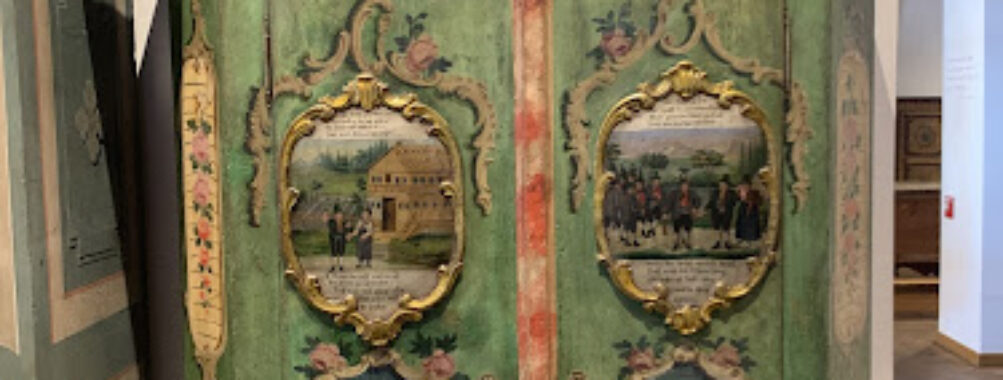
Tyrolean Folk Art Museum
“`html
Table of Contents
Description
The Tyrolean Folk Art Museum in Innsbruck is one of those places that quietly surprises you. At first glance, it might sound like just another museum with old furniture and costumes, but once you step inside, it feels more like walking into someone’s home from centuries ago. The collections are displayed in carefully reconstructed period rooms, so instead of staring at artifacts behind glass, you actually get a sense of how people lived, worked, and celebrated in Tyrol over the centuries. That’s what makes it stand out—it’s immersive without being flashy. You don’t just see a chest or a cradle; you see it in the corner of a room, where it would have belonged. It feels personal.
What’s refreshing is that the museum doesn’t try too hard. It’s not overloaded with digital screens or gimmicks, though there is an audio tour if you like that sort of thing. Instead, it lets the craftsmanship speak for itself. The painted wardrobes, the carved tools, the intricate nativity scenes—they all tell stories of everyday life in the mountains. And honestly, I found myself slowing down here, more than I usually do in museums. Maybe it’s the warmth of the wood-paneled rooms, or maybe it’s the sense that these objects were once part of real families’ lives. Either way, it’s a place that rewards curiosity and patience.
Of course, not every visitor will be equally captivated. Some might find it a bit quiet or even old-fashioned compared to more modern museums. But if you’re the kind of traveler who likes to dig a little deeper into local culture, this museum is a gem. It’s family-friendly, welcoming to all, and accessible for visitors with mobility needs. And while it doesn’t have a café inside, the old town is just outside the door, so grabbing a coffee afterward is easy enough. In short, it’s a museum that feels authentic—less about spectacle, more about substance.
Key Features
- Extensive collection of Tyrolean folk art, including furniture, tools, costumes, and religious artifacts
- Period rooms that recreate traditional living spaces from rural Tyrol
- Beautifully detailed nativity scenes, some centuries old
- Audio tour available for deeper context
- Wheelchair accessible entrance and restrooms
- Family-friendly and good for kids
- LGBTQ+ friendly and a recognized safe space
- Located right next to the Hofkirche and close to Innsbruck’s historic old town
- Free Wi-Fi available onsite
Best Time to Visit
The museum is open year-round, which makes it a reliable stop no matter the season. Personally, I think winter adds a special charm. When the snow is falling outside and the city feels hushed, stepping into those warm, wood-paneled rooms feels almost magical. The nativity scenes also take on extra meaning around Christmas. That said, summer visits have their perks too—you can pair the museum with a stroll through Innsbruck’s old town or a coffee in one of the nearby squares. If you prefer avoiding crowds, weekdays in the morning tend to be the calmest. Weekends can get busier, especially when tour groups roll through, but even then it never feels overwhelming.
How to Get There
Getting to the Tyrolean Folk Art Museum is straightforward. It sits right in the heart of Innsbruck’s old town, practically across from the Imperial Palace and next to the Hofkirche. If you’re staying anywhere central, you can easily walk there in under ten minutes. For those coming from further out, Innsbruck’s public transport system is efficient—trams and buses stop nearby, and the main train station is about a 15-minute walk. If you’re driving, parking in the old town can be tricky and pricey, so I’d recommend leaving the car at a park-and-ride and hopping on public transport. Honestly, walking through Innsbruck to get there is half the fun anyway.
Tips for Visiting
Give yourself more time than you think you’ll need. I originally planned for an hour but ended up staying closer to two because the period rooms just pulled me in. If you enjoy details, you’ll want time to linger over the painted wardrobes and tiny nativity figures. Bring headphones if you prefer to use the audio guide on your phone—it makes the experience smoother. And don’t forget to look up; the ceilings in some rooms are just as beautiful as the furniture.
If you’re traveling with kids, the museum is surprisingly engaging for them. The life-size rooms feel like little sets, and children often enjoy spotting the quirky details. For accessibility, the museum is well set up with ramps and accessible restrooms, so visitors using wheelchairs or strollers won’t struggle. Since there’s no restaurant inside, plan to grab food nearby—there are plenty of cozy cafés just steps away. And one last thing: if you’re the type who likes photos, be mindful here. Some rooms are dimly lit, and flash photography isn’t allowed, so a steady hand (or just enjoying without the camera) might be the way to go.
All in all, the Tyrolean Folk Art Museum is one of those places that doesn’t scream for attention but quietly leaves an impression. It’s not glossy or trendy, but it’s deeply rooted in the culture of Tyrol. And if you let yourself slow down and soak it in, you’ll walk away with a richer sense of what life here has looked like for centuries. That, to me, is worth far more than just ticking another attraction off a list.
“`
Location
Places to Stay Near Tyrolean Folk Art Museum
Find and Book a Tour
Explore More Travel Guides
No reviews found! Be the first to review!